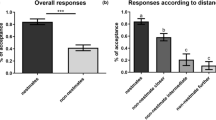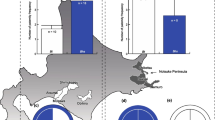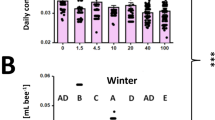Abstract
Africanized and European worker honey bee (Apis mellifera L.) ovary follicle development response to Africanized and European larval extracts and synthetic brood pheromone were measured and modeled. Africanized workers had significantly greater baseline development than European workers. Racial extracts did not differentially affect Africanized or European follicle development. Africanized EC50 of brood pheromone for follicle development inhibition was 16 times greater than for European workers. The higher worker reproductive ability of Africanized workers appeared intrinsic and was not explained by the racial blend of pheromone or composition of the adult rearing environment. Higher colony-level reproduction apparently extends to the individual-level in Africanized bees.
Zusammenfassung
Die als afrikanisierte Bienen bezeichneten Hybriden von europäischen (Apis mellifera L.) und afrikanischen (Apis mellifera scutellata) Bienenrassen sollen eine höhere Eilegerate und stärkere Follikelentwicklung haben als europäische Bienen. Wir prüften die Hypothese, dass die unterschiedliche Follikelentwicklung bei afrikanisierten und europäischen Arbeiterinnen eine Folge ist von (1) rassenspezifischen Komponenten des Larvenpheromons, (2) Dosierung des Pheromons und (3) der genetischen Zusammensetzung der zusammen gehaltenen Adultbienen. Auf der Basis der Pheromonkonzentrationen, die für eine Hemmung der Follikelentwicklung notwendig waren, wurde zusätzlich ein Modell für die Follikelentwicklung bei afrikanisierten und europäischen Arbeiterinnen entwickelt. Allgemeine Methoden: Die Rassezugehörigkeit (europäische vs. afrikanisierte Bienen) wurde über DNA (mtDNA)-Analysen bestätigt. Die Bienen wurden für 14 Tage im dunklen Brutschrank (34 °C ± 1 °C und 50 % ± 5 % RF) in Käfigen aus Plexiglas und Drahtgitter (1635 cm3) gehalten. Am 15. Tag wurden die Bienen getötet und bei −20 °C eingefroren. Die Ovariolen von 20–30 Bienen pro mtDNA-Typ und Käfig wurden unter einem Präpariermikroskop untersucht. Die Follikelentwicklung wurde in 5 Klassen von 0 = keine Entwicklung bis 4 = voll entwickelte Eier eingeteilt. Es wurden drei Experimente durchgeführt. In Experiment 1 wurde die Reaktion der Follikelentwicklung auf Extrakte von europäischen bzw. afrikanisierten Larven gemessen. Bei den afrikanisierten Bienen waren die Follikel signifikant weiter entwickelt als bei europäischen Bienen (Abb. 1). Weder bei den afrikanisierten noch bei den europäischen Bienen gab es Unterschiede zwischen den Experimenten mit afrikanisierten bzw. europäischen Larvenextrakten. In Experiment 2 wurde die dosisabhängige Follikelentwicklung bei afrikanisierten und europäischen Arbeiterinnen nach Applikation eines synthetischen Brutpheromons (Tab. I) gemessen. Die EC50 gibt die durchschnittliche effektive Konzentration des Larvenpheromons an, bei der die maximale Follikelentwicklung um 50 % reduziert wird. Diese EC50 war bei afrikanisierten Bienen 16,2 mal höher als bei europäischen Bienen (Abb. 2). In Experiment 3 testeten wir mögliche Interaktionen zwischen afrikanisierten und europäischen Bienen im selben Käfig auf die Follikelentwicklung. Die durchschnittlichen Unterschiede in der EC50 zwischen Käfigen mit gemischten Arbeiterinnen und Arbeiterinnen einer Bienenrasse betrugen −3,6 ± 3,5 und waren nicht signifikant (t = −0, 10, 5 df, P < 0,05). Zusammenfassend bleibt festzuhalten, dass afrikanisierte Arbeiterinnen bei der Follikelentwicklung eine signifikant höhere Reaktionsschwelle gegenüber Brutpheromonen haben als europäische Bienen, unabhängig von der Herkunft des Pheromons und den Haltungsbedingungen der Bienen.
Similar content being viewed by others
References
Arnold G., Le Conte Y., Trouiller J., Hervet H., Chappe B., Masson C. (1994) Inhibition of worker honeybee ovary development by a mixture of fatty acid esters from larvae, C.R. Acad. Sci. Paris, Sci. Vie 317, 511–515.
Blom van der J., Velthuis H.H.W. (1994) Simultaneous queen raising and egg laying by workers in Africanized honeybee colonies (Apis mellifera L.) in Costa Rica, Apidologie 25, 367–374.
Hellmich II R.L., Danka R.G., Collins M.A., Rinderer T.E. (1986) Laying-worker production of drones in mixed colonies of Africanized and European honey bees (Hymenoptera: Apidae), Ann. Entomol. Soc. Am. 79, 833–836.
Hoover S.E.R., Keeling C.I., Winston M.L., Slessor K.N. (2003) The effect of queen pheromones on worker honey bee ovary development, Naturwissenschaften 90, 477–480.
Hunt G.E., Collins A.M., Rivera R., Page R.E., Guzman-Novoa E. (1999) Quantitative trait loci influencing honeybee alarm pheromone levels, J. Hered. 90, 585–589.
Hunt G.J., Wood K.V., Guzman-Novoa E., Lee H.D., Rothwell A.P., Bonham C.C. (2003) Discovery of 3-methyl-2-buten-1-yl acetate, a new alarm component in the sting apparatus of Africanized honeybees, J. Chem. Ecol. 29, 453–463.
Jay S.C. (1972) Ovary development of worker honeybees when separated from worker brood by various methods, Can. J. Zool. 50, 661–664.
Jay S.C. (1975) Factors influencing ovary development of worker honeybees of European and African origin, Can. J. Zool. 53, 1387–1390.
Jay S.C., Nelson E.V. (1973) The effects of laying worker honeybees (Apis mellifera L.) and their brood on the ovary development of other worker honeybees, Can. J. Zool. 51, 629–632.
Jay S.C., Jay D.H. (1976) The effect of various types of brood comb on the ovary development of worker honeybees, Can. J. Zool. 54, 1724–1726.
Kleinbaum D.G. (1996) Logistic Regression: A Self-Learning Text, Statistics in Health Sciences, Springer, New York.
Kropakova S., Haslbachova H. (1971) The development of ovaries in worker honey bees in queen-right colonies examined before and after swarming, J. Apic. Res. 10, 57–61.
Kubisova S. (1982) Effects of fractions of larval extracts on the development of ovaries in caged worker honey bees, Acta Entomol. Bohemoslov. 79, 334–340.
Kubisova S., Haslbachova H. (1978) Effects of larval extracts on the development of ovaries in caged worker honey bees, Acta Entomol. Bohemoslov. 75, 9–14.
Lin H., Winston M.L. (1998) The role of nutrition and temperature in the ovarian development of the worker honey bee (Apis mellifera), Can. Entomol. 130, 883–891.
Mohammedi A.P., Crauser D., Le Conte Y. (1998) Effect of aliphatic esters on ovary development of queenless bees (Apis mellifera L.), Naturwissenschaften 85, 455–458.
Pankiw T. (2004) Cued in: honey bee pheromones as information flow and colony decision-making, Apidologie 35, 217–226.
Pankiw T., Winston M.L., Slessor K.N. (1995) Queen attendance behavior of worker honey bees (Apis mellifera L.) that are high and low responders to queen mandibular pheromone, Insect. Soc. 42, 371–378.
Pankiw T., Winston M.L., Plettner E., Slessor K.N. (1996) Mandibular gland pheromone components of European and Africanized honey bee queens (Apis mellifera L.), J. Chem. Ecol. 22, 605–615.
Pankiw T., Winston M.L., Fondrk M.K., Slessor K.N. (2000) Selection on worker honey bee responses to queen pheromone (Apis mellifera L.), Naturwissenschaften 87, 487–490.
Pettis J.S., Winston M.L., Collins A.M. (1995) Suppression of queen rearing in European and Africanized honey bees Apis mellifera L. by synthetic queen mandibular gland pheromone, Insect. Soc. 42, 113–121.
Pinto M.A., Johnston J.S., Rubink W.L., Coulson R.N., Patton J.C., Sheppard W.S. (2003) Identification of Africanized honey bee (Hymenoptera: Apidae) mitochondrial DNA: Validation of a rapid polymerase chain reaction-based assay, Ann. Entomol. Soc. Am. 96, 679–684.
Pinto M.A., Rubink W.L., Patton J.C., Coulson R.N., Johnston J.S. (2005) Africanization in the United States: Replacement of feral European honeybees (Apis mellifera L.) by an African hybrid swarm, Genetics 170, 1653–1665.
Ratnieks F.L.W. (1993) Egg-laying, egg-removal, and ovary development by workers in queenright honey bee colonies, Behav. Ecol. Sociobiol. 32, 191–198.
Rubink W.L., Luévano-Martínez P., Sugden E.A., Wilson W.T., Collins A.M. (1996) Subtropical Apis mellifera (Hymenoptera: Apidae) swarming in dynamics and Africanization in northeastern Mexico and southern Texas, Ann. Entomol. Soc. Am. 89, 243–251.
SigmaPlot 9.0 (2004) SPSS Science software, Chicago Ill.
Simon S.A., Nicholelis M.A.L., Ed. (2001) Methods in Chemosensory Research. NY: CRC Press, New York.
Sokal R.R., Rohlf F.J. (1995) Biometry, The principles and practice of statistics in biological Research, W.H. Freeman and Company, New York.
SPSS 11.5 (2000) SPSS Science software, Chicago, Ill.
Sugden E.A., Williams K.R. (1990) October 15: the day the bee arrived, Gleanings Bee Culture 119, 18–21.
Winston M.L., Taylor O., Otis G.W. (1983) Some differences between temperate European and tropical African and South American honeybees, Bee World 64, 12–21.
Author information
Authors and Affiliations
Corresponding author
Additional information
Manuscript editor: Klaus Hartfelder
Rights and permissions
About this article
Cite this article
Pankiw, T., Garza, C. Africanized and European honey bee worker ovarian follicle development response to racial brood pheromone extracts. Apidologie 38, 156–163 (2007). https://doi.org/10.1051/apido:2006066
Received:
Revised:
Accepted:
Issue Date:
DOI: https://doi.org/10.1051/apido:2006066




